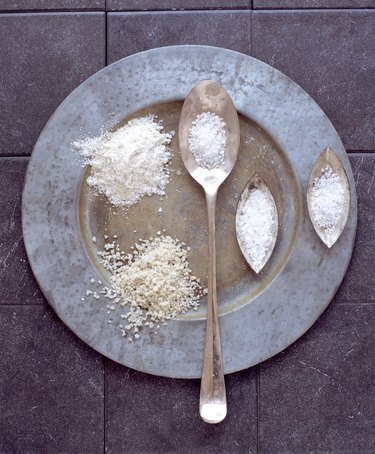
Brining and curing are both ancient methods that were used primarily to store meat to eat safely at a later time. Cures and brines are still used to preserve meat, but now that we keep most of our food in the refrigerator, many cooks use these two processes to infuse food with flavor or moisture. Curing and brining are essentially variations on the same process, but a few minor differences account for a wide spectrum of uses and results.
Definitions
Video of the Day
Curing is the name given to a range of processes for preserving and flavoring foods, particularly meat and fish. A combination of salt, sugar and nitrate or nitrite is added to the food, inhibiting the growth of bacteria for long-term preservation. Brining is the process of treating foods with a salt water solution, either by submerging or injecting. The brine increases the amount of moisture in the meat's tissue cells, producing a juicy, flavorful meal once cooked.
Video of the Day
Similarities
Curing is an umbrella term that includes any method of preserving food with salt, sugar, nitrate or nitrite. Brining is one form of curing, sometimes called brine curing, wet curing or pickling. A brine solution is simply a dry cure mixture dissolved in water. Basic brines consist of only salt and water, but you can add nitrate or nitrite, sugar, honey, herbs and spices. Both curing and brining work through a process called osmosis, though with different results. While a cure simply removes water from cells to prevent bacterial growth, a brine draws even more water back in, resulting in moist, juicy foods.
Differences
Aside from the addition of water, a few major differences between curing and brining exist. While cures are used primarily as a means of preserving, a brine's most common purpose is to infuse foods with moisture and flavor. Curing most often refers to a process involving fish or meat. While brines are commonly used with meats, they are also a necessary step in the production of some cheeses and to improve the bitter taste of fresh olives. Jarred vegetables like pickles, peppers and artichokes are packed in a brine solution for added flavor and safe storage.
Uses
Curing is the process responsible for many of our favorite meats like bacon, some sausages, pastrami, salami and prosciutto. Dry cures are rubbed directly on the surface of the meat, which is then left out to "cure" for some time – about one week per inch of thickness. Once cured, the meat is sometimes slowly smoked to improve flavor and color and to lengthen its shelf life. While dry cures are most often left to the professionals, brines are a home cook's best friend. Whole chickens and turkeys, chicken parts, ribs, pork chops and even shrimp benefit from a simple brining before cooking. Your cooked dish will be more moist and flavorful than untreated versions.